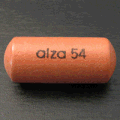Osmotic-controlled release oral delivery system
Osmotic-controlled release oral delivery system (OROS) is a pharmaceutical technology that allows for the release of drugs through osmotic pressure. This system is designed to improve the bioavailability of medications, ensure a controlled release of drug substances, and maintain consistent plasma levels of the drug over an extended period. OROS technology is particularly beneficial for drugs that require a steady release into the bloodstream to achieve optimal therapeutic effect or for those with a narrow therapeutic window.
Overview[edit]
The osmotic-controlled release oral delivery system utilizes a semi-permeable membrane surrounding an osmotically active drug core. The core typically contains the drug itself and osmotically active components, which can draw water into the tablet. As water enters the core through the semi-permeable membrane due to osmotic pressure differences, it dissolves the drug, which is then released through a laser-drilled hole in the membrane at a controlled rate.
Components[edit]
The main components of an OROS tablet include:
- Drug layer: Contains the active pharmaceutical ingredient (API).
- Push layer: Contains osmotically active components that expand upon water absorption, helping to push the drug out of the tablet.
- Semi-permeable membrane: Allows water to enter but prevents the drug and osmotic agents from leaving the tablet.
- Delivery orifice: A small hole, usually created by laser drilling, through which the drug is released.
Advantages[edit]
- Controlled release: OROS technology provides a controlled, predictable release of the drug, enhancing treatment efficacy and patient compliance.
- Reduced side effects: By maintaining steady drug levels in the blood, the risk of peak-related side effects is minimized.
- Improved bioavailability: Consistent drug levels can improve the overall bioavailability of certain medications, making treatment more effective.
- Convenience: Reduced dosing frequency improves patient compliance and convenience.
Applications[edit]
OROS technology has been applied to a wide range of drugs, including those for the treatment of hypertension, chronic pain, attention deficit hyperactivity disorder (ADHD), and diabetes mellitus. It is particularly useful for drugs that are either rapidly eliminated from the body or require a constant blood level to be effective.
Challenges[edit]
While OROS offers numerous benefits, there are challenges in its development, including the complexity of the manufacturing process, the need for specialized equipment, and potential issues with the size of the final dosage form, which may affect patient compliance.
Conclusion[edit]
The osmotic-controlled release oral delivery system represents a significant advancement in drug delivery technology, offering benefits in terms of controlled drug release, improved efficacy, and patient compliance. As pharmaceutical science advances, the applications of OROS technology are expected to expand, providing more options for the treatment of various conditions.
-
Concerta 54mg OROS tablet
-
Elementary Osmotic Pump diagram
-
Push-Pull Osmotic Pump diagram
-
Concerta OROS overcoat
-
Concerta OROS diagram
Ad. Transform your life with W8MD's Budget GLP-1 injections from $75


W8MD offers a medical weight loss program to lose weight in Philadelphia. Our physician-supervised medical weight loss provides:
- Weight loss injections in NYC (generic and brand names):
- Zepbound / Mounjaro, Wegovy / Ozempic, Saxenda
- Most insurances accepted or discounted self-pay rates. We will obtain insurance prior authorizations if needed.
- Generic GLP1 weight loss injections from $75 for the starting dose.
- Also offer prescription weight loss medications including Phentermine, Qsymia, Diethylpropion, Contrave etc.
NYC weight loss doctor appointmentsNYC weight loss doctor appointments
Start your NYC weight loss journey today at our NYC medical weight loss and Philadelphia medical weight loss clinics.
- Call 718-946-5500 to lose weight in NYC or for medical weight loss in Philadelphia 215-676-2334.
- Tags:NYC medical weight loss, Philadelphia lose weight Zepbound NYC, Budget GLP1 weight loss injections, Wegovy Philadelphia, Wegovy NYC, Philadelphia medical weight loss, Brookly weight loss and Wegovy NYC
|
WikiMD's Wellness Encyclopedia |
| Let Food Be Thy Medicine Medicine Thy Food - Hippocrates |
Medical Disclaimer: WikiMD is not a substitute for professional medical advice. The information on WikiMD is provided as an information resource only, may be incorrect, outdated or misleading, and is not to be used or relied on for any diagnostic or treatment purposes. Please consult your health care provider before making any healthcare decisions or for guidance about a specific medical condition. WikiMD expressly disclaims responsibility, and shall have no liability, for any damages, loss, injury, or liability whatsoever suffered as a result of your reliance on the information contained in this site. By visiting this site you agree to the foregoing terms and conditions, which may from time to time be changed or supplemented by WikiMD. If you do not agree to the foregoing terms and conditions, you should not enter or use this site. See full disclaimer.
Credits:Most images are courtesy of Wikimedia commons, and templates, categories Wikipedia, licensed under CC BY SA or similar.
Translate this page: - East Asian
中文,
日本,
한국어,
South Asian
हिन्दी,
தமிழ்,
తెలుగు,
Urdu,
ಕನ್ನಡ,
Southeast Asian
Indonesian,
Vietnamese,
Thai,
မြန်မာဘာသာ,
বাংলা
European
español,
Deutsch,
français,
Greek,
português do Brasil,
polski,
română,
русский,
Nederlands,
norsk,
svenska,
suomi,
Italian
Middle Eastern & African
عربى,
Turkish,
Persian,
Hebrew,
Afrikaans,
isiZulu,
Kiswahili,
Other
Bulgarian,
Hungarian,
Czech,
Swedish,
മലയാളം,
मराठी,
ਪੰਜਾਬੀ,
ગુજરાતી,
Portuguese,
Ukrainian





